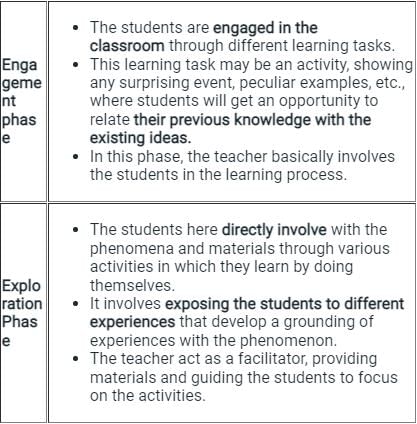Civil Engineering (CE) Exam > Civil Engineering (CE) Questions > While teaching the concept of fractions to st...
Start Learning for Free
While teaching the concept of fractions to students of VI-grade, a teacher performed the following task: Distributed few pieces of paper (circular, rectangular shape) and thread to all the students and ask them to divide them into two parts. The students may divide the paper/thread either into equal or unequal parts. The above scenario indicates which sequential phase of 5 E’s learning model?
- a)Evaluation phase
- b)Elaboration phase
- c)Explanation phase
- d)Engagement phase
Correct answer is option 'D'. Can you explain this answer?
Most Upvoted Answer
While teaching the concept of fractions to students of VI-grade, a tea...
The above scenario indicates the first phase of the 5 E instructional model, which is "Engage." In this phase, the teacher engages students in the topic or concept by presenting an activity or scenario that piques their interest and stimulates their thinking. The task of dividing the paper/thread into two parts encourages students to think about fractions and how they can be divided into equal or unequal parts. It sets the stage for further exploration and learning about fractions.
Free Test
FREE
| Start Free Test |
Community Answer
While teaching the concept of fractions to students of VI-grade, a tea...
The 5 E's learning model, developed by 'Rodger Bybee' is an instructional model based on five stages which are engaging, exploration, explanation, elaboration, and evaluation.
- This constructivist model of learning ensures the active involvement of learners in the teaching-learning process.
Key Points
The 5 E's learning model is briefly explained below:
The 5 E's learning model is briefly explained below:



Hence, we can conclude that the above scenario relates to the Engagement Phase of 5 E's model of learning.

|
Explore Courses for Civil Engineering (CE) exam
|

|
Question Description
While teaching the concept of fractions to students of VI-grade, a teacher performed the following task: Distributed few pieces of paper (circular, rectangular shape) and thread to all the students and ask them to divide them into two parts. The students may divide the paper/thread either into equal or unequal parts. The above scenario indicates which sequential phase of 5 E’s learning model?a)Evaluation phaseb)Elaboration phasec)Explanation phased)Engagement phaseCorrect answer is option 'D'. Can you explain this answer? for Civil Engineering (CE) 2025 is part of Civil Engineering (CE) preparation. The Question and answers have been prepared according to the Civil Engineering (CE) exam syllabus. Information about While teaching the concept of fractions to students of VI-grade, a teacher performed the following task: Distributed few pieces of paper (circular, rectangular shape) and thread to all the students and ask them to divide them into two parts. The students may divide the paper/thread either into equal or unequal parts. The above scenario indicates which sequential phase of 5 E’s learning model?a)Evaluation phaseb)Elaboration phasec)Explanation phased)Engagement phaseCorrect answer is option 'D'. Can you explain this answer? covers all topics & solutions for Civil Engineering (CE) 2025 Exam. Find important definitions, questions, meanings, examples, exercises and tests below for While teaching the concept of fractions to students of VI-grade, a teacher performed the following task: Distributed few pieces of paper (circular, rectangular shape) and thread to all the students and ask them to divide them into two parts. The students may divide the paper/thread either into equal or unequal parts. The above scenario indicates which sequential phase of 5 E’s learning model?a)Evaluation phaseb)Elaboration phasec)Explanation phased)Engagement phaseCorrect answer is option 'D'. Can you explain this answer?.
While teaching the concept of fractions to students of VI-grade, a teacher performed the following task: Distributed few pieces of paper (circular, rectangular shape) and thread to all the students and ask them to divide them into two parts. The students may divide the paper/thread either into equal or unequal parts. The above scenario indicates which sequential phase of 5 E’s learning model?a)Evaluation phaseb)Elaboration phasec)Explanation phased)Engagement phaseCorrect answer is option 'D'. Can you explain this answer? for Civil Engineering (CE) 2025 is part of Civil Engineering (CE) preparation. The Question and answers have been prepared according to the Civil Engineering (CE) exam syllabus. Information about While teaching the concept of fractions to students of VI-grade, a teacher performed the following task: Distributed few pieces of paper (circular, rectangular shape) and thread to all the students and ask them to divide them into two parts. The students may divide the paper/thread either into equal or unequal parts. The above scenario indicates which sequential phase of 5 E’s learning model?a)Evaluation phaseb)Elaboration phasec)Explanation phased)Engagement phaseCorrect answer is option 'D'. Can you explain this answer? covers all topics & solutions for Civil Engineering (CE) 2025 Exam. Find important definitions, questions, meanings, examples, exercises and tests below for While teaching the concept of fractions to students of VI-grade, a teacher performed the following task: Distributed few pieces of paper (circular, rectangular shape) and thread to all the students and ask them to divide them into two parts. The students may divide the paper/thread either into equal or unequal parts. The above scenario indicates which sequential phase of 5 E’s learning model?a)Evaluation phaseb)Elaboration phasec)Explanation phased)Engagement phaseCorrect answer is option 'D'. Can you explain this answer?.
Solutions for While teaching the concept of fractions to students of VI-grade, a teacher performed the following task: Distributed few pieces of paper (circular, rectangular shape) and thread to all the students and ask them to divide them into two parts. The students may divide the paper/thread either into equal or unequal parts. The above scenario indicates which sequential phase of 5 E’s learning model?a)Evaluation phaseb)Elaboration phasec)Explanation phased)Engagement phaseCorrect answer is option 'D'. Can you explain this answer? in English & in Hindi are available as part of our courses for Civil Engineering (CE).
Download more important topics, notes, lectures and mock test series for Civil Engineering (CE) Exam by signing up for free.
Here you can find the meaning of While teaching the concept of fractions to students of VI-grade, a teacher performed the following task: Distributed few pieces of paper (circular, rectangular shape) and thread to all the students and ask them to divide them into two parts. The students may divide the paper/thread either into equal or unequal parts. The above scenario indicates which sequential phase of 5 E’s learning model?a)Evaluation phaseb)Elaboration phasec)Explanation phased)Engagement phaseCorrect answer is option 'D'. Can you explain this answer? defined & explained in the simplest way possible. Besides giving the explanation of
While teaching the concept of fractions to students of VI-grade, a teacher performed the following task: Distributed few pieces of paper (circular, rectangular shape) and thread to all the students and ask them to divide them into two parts. The students may divide the paper/thread either into equal or unequal parts. The above scenario indicates which sequential phase of 5 E’s learning model?a)Evaluation phaseb)Elaboration phasec)Explanation phased)Engagement phaseCorrect answer is option 'D'. Can you explain this answer?, a detailed solution for While teaching the concept of fractions to students of VI-grade, a teacher performed the following task: Distributed few pieces of paper (circular, rectangular shape) and thread to all the students and ask them to divide them into two parts. The students may divide the paper/thread either into equal or unequal parts. The above scenario indicates which sequential phase of 5 E’s learning model?a)Evaluation phaseb)Elaboration phasec)Explanation phased)Engagement phaseCorrect answer is option 'D'. Can you explain this answer? has been provided alongside types of While teaching the concept of fractions to students of VI-grade, a teacher performed the following task: Distributed few pieces of paper (circular, rectangular shape) and thread to all the students and ask them to divide them into two parts. The students may divide the paper/thread either into equal or unequal parts. The above scenario indicates which sequential phase of 5 E’s learning model?a)Evaluation phaseb)Elaboration phasec)Explanation phased)Engagement phaseCorrect answer is option 'D'. Can you explain this answer? theory, EduRev gives you an
ample number of questions to practice While teaching the concept of fractions to students of VI-grade, a teacher performed the following task: Distributed few pieces of paper (circular, rectangular shape) and thread to all the students and ask them to divide them into two parts. The students may divide the paper/thread either into equal or unequal parts. The above scenario indicates which sequential phase of 5 E’s learning model?a)Evaluation phaseb)Elaboration phasec)Explanation phased)Engagement phaseCorrect answer is option 'D'. Can you explain this answer? tests, examples and also practice Civil Engineering (CE) tests.

|
Explore Courses for Civil Engineering (CE) exam
|

|
Signup for Free!
Signup to see your scores go up within 7 days! Learn & Practice with 1000+ FREE Notes, Videos & Tests.


















